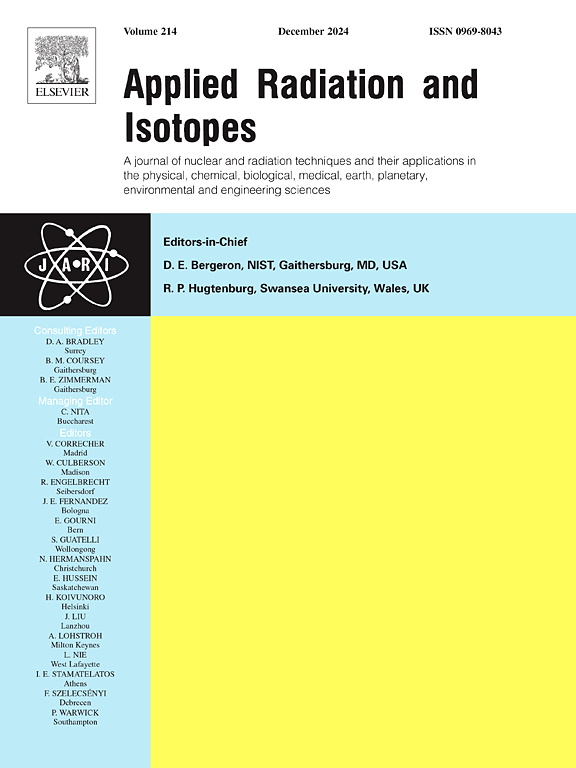Double-filter monitor for simultaneous measurement of Radon and its progeny
IF 1.6
3区 工程技术
Q3 CHEMISTRY, INORGANIC & NUCLEAR
引用次数: 0
Abstract
For simultaneous measurement of radon and its progeny, double filter monitor based on Direct progeny sensors (DRPS) was developed. DRPS is an absorber mounted LR115 detector which measures the progeny concentration. Double filter consisted of two filters, inlet and exit filter, which were utilised in the monitor for progeny atom deposition such that the ambient progeny atoms get deposited on the inlet filter and the progeny formed due to decay of radon sampled inside the delay volume get deposited on the exit filter. DRPS facing the inlet filter would detect the alpha particles emitted during decay of progeny on inlet filter and that will correspond to ambient progeny concentration. Similarly DRPS placed facing the exit filter will detect the alpha particles emitted during the decay of progeny on exit filter, which is related to ambient radon concentration. Thus the system has two filters and two progeny sensors. The loss of progeny atoms formed during the decay of ingressed radon inside the delay chamber may be lost due to plate-out on the walls of the delay chamber. The plate-out loss is characterised by diffusion parameter. Theoretical calculations of transit time of progeny atoms in the delay volume at different flow rates were also used to study the effect of volume of the chamber at different flow rates. The system was calibrated in known activities of radon and its progeny and the calibration factors were measured. Additional advantage of the system is that in-situ equilibrium factor can be measured.
同时测量氡及其子体的双滤式监测仪
为了同时测量氡及其子体,研制了基于直接子体传感器(DRPS)的双滤光监测仪。DRPS是一种安装在吸收体上的LR115探测器,用于测量子代浓度。双滤光片由入口和出口两个滤光片组成,用于子代原子沉积监测仪,使周围的子代原子沉积在入口滤光片上,延时体积内采样的氡衰变形成的子代沉积在出口滤光片上。面对入口滤波器的DRPS将检测子代在入口滤波器上衰变时发射的α粒子,并将其与周围的子代浓度相对应。同样,面对出口滤波器的DRPS将检测子代在出口滤波器上衰变时发射的α粒子,这与环境氡浓度有关。因此,该系统具有两个滤波器和两个子传感器。进入延迟室的氡在衰变过程中形成的子代原子的损失可能是由于延迟室壁上的板出而损失的。镀板损耗用扩散参数来表征。理论计算了不同流量下子代原子在延迟体积中的传递时间,研究了不同流量下腔体体积对延迟体积的影响。在已知氡及其子体活度条件下对系统进行了标定,并对标定因子进行了测定。该系统的另一个优点是可以测量原位平衡因子。
本文章由计算机程序翻译,如有差异,请以英文原文为准。
求助全文
约1分钟内获得全文
求助全文
来源期刊

Applied Radiation and Isotopes
工程技术-核科学技术
CiteScore
3.00
自引率
12.50%
发文量
406
审稿时长
13.5 months
期刊介绍:
Applied Radiation and Isotopes provides a high quality medium for the publication of substantial, original and scientific and technological papers on the development and peaceful application of nuclear, radiation and radionuclide techniques in chemistry, physics, biochemistry, biology, medicine, security, engineering and in the earth, planetary and environmental sciences, all including dosimetry. Nuclear techniques are defined in the broadest sense and both experimental and theoretical papers are welcome. They include the development and use of α- and β-particles, X-rays and γ-rays, neutrons and other nuclear particles and radiations from all sources, including radionuclides, synchrotron sources, cyclotrons and reactors and from the natural environment.
The journal aims to publish papers with significance to an international audience, containing substantial novelty and scientific impact. The Editors reserve the rights to reject, with or without external review, papers that do not meet these criteria.
Papers dealing with radiation processing, i.e., where radiation is used to bring about a biological, chemical or physical change in a material, should be directed to our sister journal Radiation Physics and Chemistry.
 求助内容:
求助内容: 应助结果提醒方式:
应助结果提醒方式:


